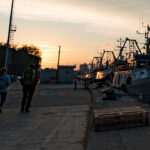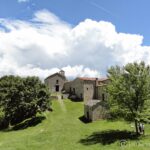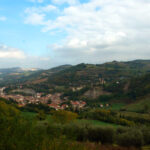Distance: Km 20
Estimated time: 5 h
Departure: Bagnacavallo
Intermediate stages: church of San Pietro in Silvis, San Potito house of Nilde Guerra, Cotignola, Madonna della Salute church in Solarolo
Arrival: Solarolo
Description of the stage
From the church of Pieve di San Pietro in Silvis di Bagnacavallo take via Bagnoli inf., Then turn right into via Bruciamolina. Going straight, it becomes Via Storta, where at number 13, you can stop at the house where Nilde Guerra lived venerated. Continue on the Senio embankment, when you reach the crossroads with the via closed, you pass in front of the memorial 3579 to remember the breakthrough of the German defensive line of the Segno river in April 1945.
Cross the bridge and continue on the other bank of the river. You get to Cotignola, in Piazza Vittorio Emanuele II there is a fountain. Continuing on, in Piazza della resistenza there are two steles 2306, 2307 in memory of the Second World War. Continue along the river embankment, at the height of via Ponte Pietra (Provincial road 62), there is a fountain and a panel illustrating the former mill of the town of Cotignola (Chiusaccia). Proceeding along the embankment, you will join the Provincial Road 7, and after 200 meters of via Corriera turn right into via Fabbretti. Going always right you get to the Sanctuary of the Madonna della Salute of Solarolo.
Then take Via Madonna della Salute and at the end turn right towards the center of the village where there will be the church of S. Maria Assunta in Solarolo.
Important information: in some periods of the year there may be the grass of the rival a bit ‘high (especially far from population centers), which hinders the pedestrian crossing. In these cases you can go through the country lanes that line the rival, in this case the roads are not marked; in the map at the bottom of the page there is the recommended route.
Interesting sites
The route is all flat and flows in the lower Faenza Romagna, between the parishes and the beautiful countryside of Romagna full of orchards, vineyards and cereals.
The route is traced by the historic Via dei Romei (Middle Ages), which crossed the ancient Via Faenza (II century BC) to get to Rome through the Faenza Apennines, passing through Florence arriving in Rome Eternal City.
Our journey begins with the parish church of San Pietro in Sylvis, a noteworthy example of Proto-Romanesque or seventh-century exarcal architecture, among the most beautiful and best preserved in Romagna. The ancient church seems to correspond to the easternmost of the ports along the southern bank of the delta marshes. It has a sober façade and an isolated bell tower. Inside, divided into three naves with rounded arches on pillars, a small altar from the 7th century stands out in the raised presbytery. The apse, with a polygonal layout, bears frescoes perhaps of a master from Rimini (1320-25). They depict the Redeemer among the evangelists, the apostles and Christ crucified between the Madonna and St. John.
Bagnacavallo always maintained relations with the cities of the Via Emilia since the town, beyond a road that led to Faenza, indicated as a strata magistra in the Descriptio of 1371, merchants and pilgrims could count on the navigable courses of Senio-Santerno and Lamone. Continuing in the ancient “castrum Tiberiacum”, now called Bagnacavallo, the pilgrims found an inhabited area very different from today. Of the two-fourteenth century town remains the traces of the blocks in what is now the northern part of the historical center. In Piazza Libertà, where beautiful old porticoed streets radiate out, the tower (also known as the clock) and the adjoining Palazzo Vecchio remain perhaps from the early 13th century.
Continuing the journey we pass by S. Potito in front of the house of the venerable Nilde Guerra.
Crossing orchards and well-cultivated fields we reach the town of Cotignola, this territory took the name of Cotignola, as attested by a document of 1177. City of Roman origin but it is in the XIII century Cotignola experienced a period of continuous struggles. Several dominants succeeded each other, with the Faentini, Estensi, Lughesi and finally the state of the Church from 1409 to 1859 with brief brackets from the Sforza to the Venetians. In 1372 it was linked by Pope Gregory XI to the City of Faenza and given to Giovanni Acuto, he decided to surround Cotignola with new walls. From then on the town was considered of great importance and considerable importance, as it is written in the notary deed of the Notary Pio of Quondam Zangolino de Pedercinis dated 23 June 1376 and kept in the Cotignola archive. The only monument that has been able to resist the bombings of the Second World War is the monastery of the Minori Osservanti of the fifteenth century. The church is dedicated to St. Francis and preserves inside a glass case the uncorrupted body of the Blessed Antonio Bonfadini, the Ferrara preacher who returned from the Holy Land to Cotignola and died here in 1482. The monument preserves its splendid interior paintings by the Marchesi and the Zaganelli, dating back to the fifteenth century, as well as the ceramic works of Bassi, ceramist and contemporary painter.
Among the religious buildings, there is also the Collegiata S. Stefano Protomartire, built in 1376. In the presbytery there is the sepulcher of the Archbishop of Dubrovnick Rinaldo Graziani, sculpted by Pietro Barilotto from Faenza in the XVI century, and inside the building you can admire a valuable table of the Carracci school. Other monuments we have: the Torre d’Acuto and the ancient Roman church of Santo Stefano in Barbiano.
Solarolo city of arrival in this stage: The first human communities of the Solarolese territory dates back to the Middle Bronze Age (17th century – XVth century BC) The Roman colonization of the territory is much more well documented, linked to the events of Bonomy – Bologna, then Faventia – Faenza and Forum Cornelii – Imola. The “limitatio” (centuriation), undertaken starting from 187 BC, the medieval period is characterized by the successive dominions of Faenza longer, Bologna and finally the State of the Church until the event of the unification of Italy in which it is inserted in the municipality of Faenza. Even the municipality of Solarolo in the fascist period and in the conflict of the Second World War suffers destruction and victims. The reconstruction, proceeded slowly, it can be said ended, the new urbanization has grown with criteria on a human scale. It is a modern municipality and the main monuments of the territory are: the Oratory of the Annunciation, the Manfredian Walls, the Gate of the Castle and the Sanctuary of the Blessed Virgin of Health; made between 1731 and 1736 on a design by Faetano Carlo Cesare Scaletta, with a high altar in precious marble by the Toschini brothers of Ravenna. The Sanctuary became a worthy seat of a ceramic image of the Madonna, The popular devotion is testified by numerous votive offerings preserved there.












